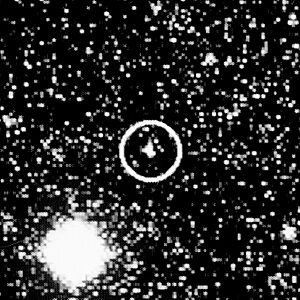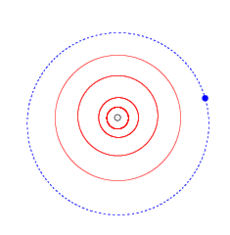15760 Albion facts for kids

Long-exposure image of Albion (circled) taken by the European Southern Observatory in September 1992
|
|
| Discovery | |
|---|---|
| Discovered by | D. C. Jewitt J. X. Luu |
| Discovery site | Mauna Kea Obs. |
| Discovery date | 30 August 1992 |
| Designations | |
| MPC designation | (15760) Albion |
|
Named after
|
Albion (mythology by William Blake) |
| 1992 QB1 | |
| TNO · cubewano (cold) distant |
|
| Orbital characteristics | |
| Epoch 31 May 2020 (JD 2459000.5) | |
| Uncertainty parameter 3 | |
| Observation arc | 26.34 yr (9,621 days) |
| Aphelion | 47.042 AU |
| Perihelion | 40.809 AU |
| 43.925 AU | |
| Eccentricity | 0.07096 |
| 291.13 yr (106,334 days) | |
| 34.041° | |
|
Mean motion
|
0° 0m 12.188s / day |
| Inclination | 2.1797° |
| 359.276° | |
| 0.7765° | |
| Physical characteristics | |
|
Mean diameter
|
108 km 167 km |
| 0.2 (assumed) | |
| RR (red) B–V=0.869±0.143 V−R=0.707±0.093 V−I=1.212±0.146 |
|
| 23.3 | |
| 7.38±0.06 · 7.1 | |
15760 Albion is a small, icy world found far beyond Neptune. It was the very first object discovered in the Kuiper Belt after Pluto and its moon, Charon. Scientists call it a "trans-Neptunian object" because it orbits the Sun past Neptune.
Albion is about 108 to 167 kilometers wide. That's roughly the size of a small city! It was found in 1992 by two astronomers, David C. Jewitt and Jane X. Luu. They made this exciting discovery at the Mauna Kea Observatory in Hawaii.
When it was first found, the press even called it the "tenth planet." Albion is also known as a "cubewano." This special name comes from its original temporary name, "1992 QB1." The "QB1" part inspired the name for this type of object.
Discovering Albion
Albion was found on August 30, 1992. Its discovery was a big deal because it showed that the Kuiper Belt was full of many more objects than just Pluto. Before Albion, scientists only knew about Pluto and Charon in that distant region.
The temporary name "1992 QB1" tells us something interesting. The "QB1" means it was the 27th object found in the second half of August that year. Since Albion's discovery, thousands more objects have been found in the Kuiper Belt. Most of these are also "classical Kuiper Belt objects," just like Albion.
Naming Albion
This small world is named after a character called Albion. This character comes from the detailed stories created by the English poet and painter William Blake (1757–1827). In Blake's stories, Albion is an ancient, giant human who lives on an island. The name "Albion" itself is an old, mythical name for Britain.
The astronomers who found Albion first thought of calling it "Smiley." However, that name was already used for another asteroid called 1613 Smiley. That asteroid was named after an American astronomer, Charles Hugh Smiley. So, 15760 Albion remained without a formal name until January 2018. Before then, people often just called it "QB1."
Albion's Legacy
Albion's discovery opened up a whole new area of space exploration. In the years after 1992, many more objects like Albion were found. These included (15788) 1993 SB, (15789) 1993 SC, and (181708) 1993 FW.
Over the next 20 years, more than a thousand objects were discovered in the Kuiper Belt. This region orbits the Sun between about 30 and 50 AU (AU is the distance from the Earth to the Sun). This showed that the Kuiper Belt is a huge area filled with many icy bodies, not just Pluto and Albion. By 2018, over 2,000 Kuiper Belt objects had been found.
See also
 In Spanish: (15760) Albion para niños
In Spanish: (15760) Albion para niños
- (181708) 1993 FW
- List of trans-Neptunian objects
- Kuiper belt


